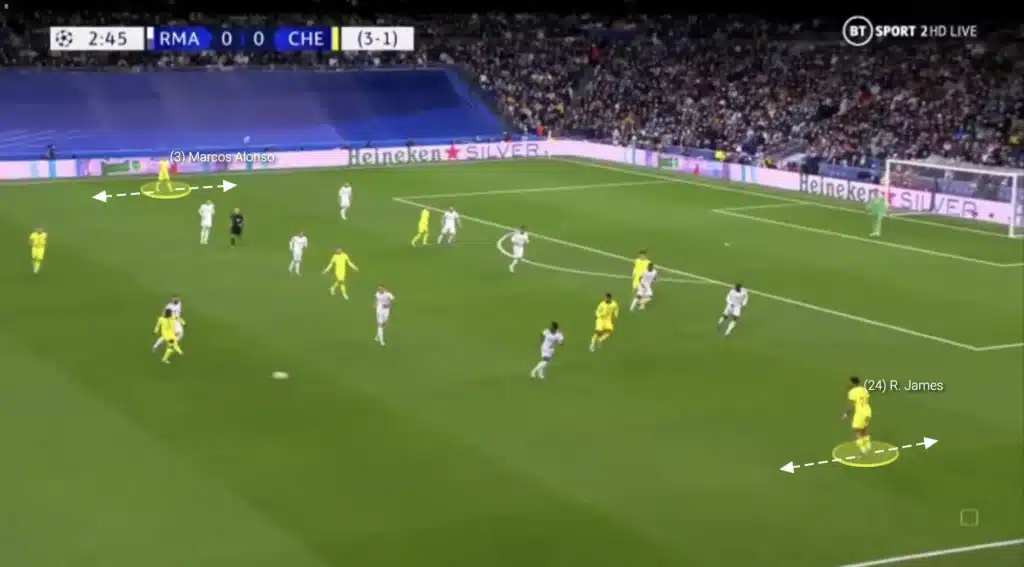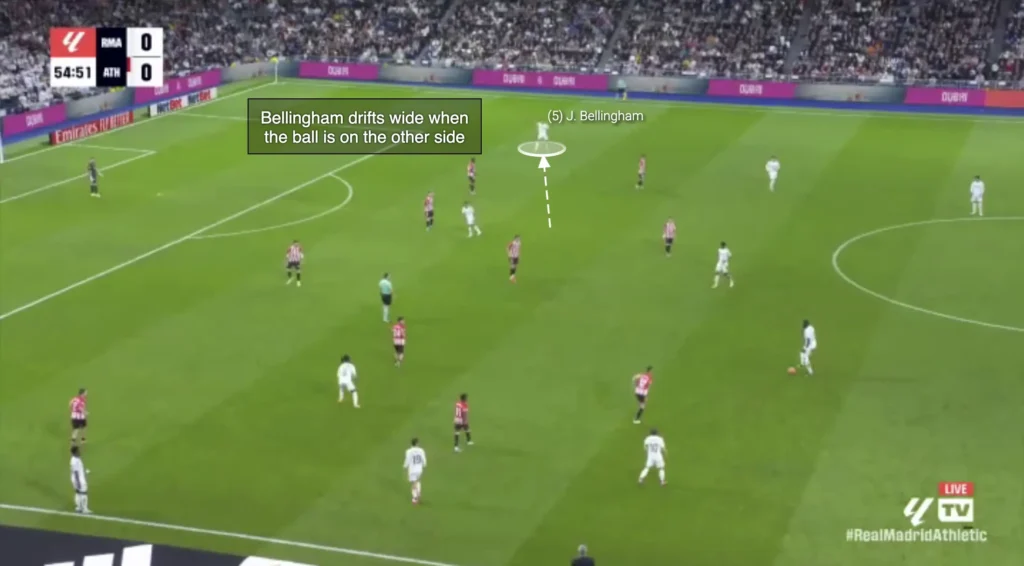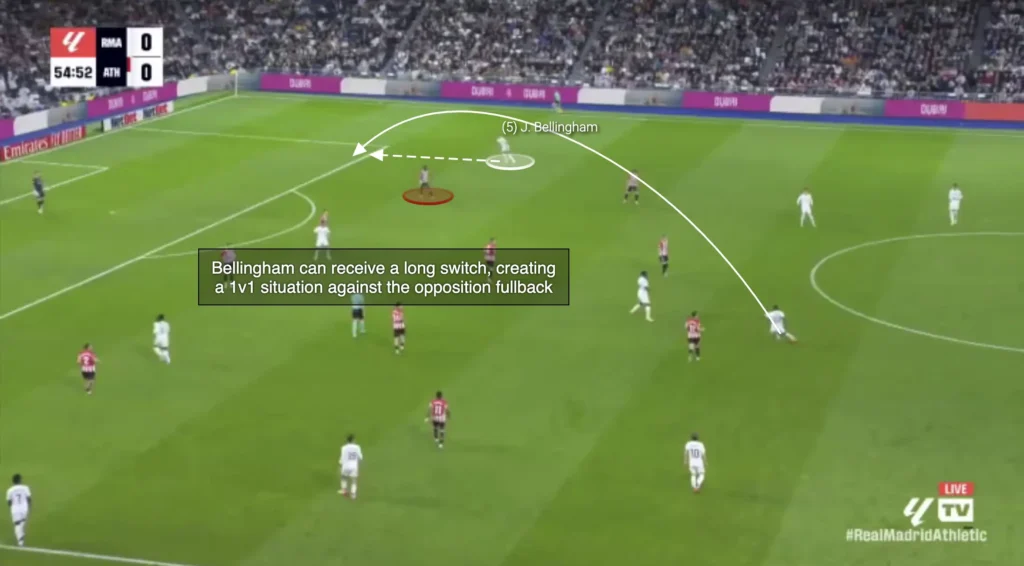Width is one of the most important dimensions of attacking play. It dictates how space is created, how defenders are stretched, and how attacking structures are built. Yet width is not always used in the same way. Two distinct tactical ideas — positional width and functional width — describe how wide areas can be occupied for different purposes.
Although they often appear in the same system, they carry different principles and implications. Understanding the distinction helps coaches design more effective attacking frameworks, allows analysts to interpret patterns with clarity, and gives scouts sharper tools for evaluating tactical fit.
Positional Width: Structure Before Action
Positional width is about securing wide zones as part of the team’s overall positional framework. It is primarily structural: players occupy wide spaces to ensure the team is stretched, balanced, and capable of circulating the ball across the pitch.
- Fixed Occupation: One or more players are tasked with holding wide positions (e.g., wingers, wing-backs, or fullbacks in a back four).
- Constant Presence: Even if the ball is far away, those players remain wide to guarantee spacing.
- Predictable Distribution: Because width is always secured, the team maintains stable passing lanes and angles.

The tactical function of positional width is to prevent the defending team from compressing too tightly. If attackers never maintain wide positions, opponents can easily collapse into central areas, closing down key spaces between the lines. By holding the width, attackers stretch the block horizontally and force defenders into constant decisions: remain compact and risk leaving wide zones exposed, or shift across and risk opening central gaps.
Positional width, then, is less about individual initiative and more about ensuring a collective structure that sustains balance and circulation.
Functional Width: Action Before Structure
Functional width, by contrast, is dynamic. It is not tied to fixed players or zones but emerges situationally when a specific attacking action demands it. Width is created not for permanent spacing but to achieve a tactical effect in a given moment.
- Flexible Responsibility: Any player may provide width depending on the situation — a midfielder drifting wide, a striker running into the channel, or even a center-back stepping out.
- Ball-Oriented: Width is often created as a reaction to the ball’s location, opponent positioning, or pressing triggers.
- Temporary: Once the purpose is achieved — for example, isolating a defender or unbalancing a block — the wide occupation can dissolve quickly.
Functional width is, therefore, about manipulation rather than structure. By creating width at the right time, a team can drag defenders into uncomfortable positions, open lanes inside, or create isolation scenarios for a 1v1.


Unlike positional width, which exists continuously as a framework, functional width appears and disappears depending on the tactical requirements of the moment.
Key Tactical Differences
The distinction between positional and functional width can be summarized in several key points:
- Focus: Positional width prioritizes long-term spacing, while functional width prioritizes short-term manipulation.
- Responsibility: Positional width is often tied to specific roles (winger, fullback), while functional width can be taken on by different players as the game evolves.
- Timing: Positional width exists permanently as part of the structure; functional width is temporary and triggered by immediate tactical needs.
- Purpose: Positional width stretches the defensive block horizontally to secure balance; functional width targets immediate advantages, such as isolating a defender, freeing a runner, or creating an overload.
- Risks: Over-reliance on positional width can make attacks predictable and too rigid, while over-reliance on functional width can lead to poor spacing and vulnerability in transition.
Why and How to Use Positional Width
Positional width is essential for building stable attacking frameworks. Without it, teams struggle to circulate the ball, stretch defenses, and maintain balance in rest-defence.
Why?
- It prevents defensive units from overloading the center.
- It provides predictable spacing for circulation and switches of play.
- It ensures that attacking structures remain balanced, especially when possession is lost.
How?
- Assign clear roles: specific players are responsible for maintaining wide occupation at all times.
- Train spacing discipline: players must learn to “hold the width” even when the ball is far away or they are less directly involved.
- Use positional rondos or small-sided games with wide channels where occupation is mandatory, reinforcing the principle that structure comes before action.
Why and How to Use Functional Width
Functional width is equally valuable, but it serves a very different purpose. Where positional width stabilizes, functional width destabilizes.
Why?
- It manipulates defenders in real time, forcing them into uncomfortable decisions.
- It creates isolation scenarios where attackers can exploit 1v1 duels.
- It frees central lanes by dragging defenders away from compact positions.
How?
- Encourage flexibility: any player can provide width depending on cues and triggers.
- Train situational recognition: players must understand when to move wide to create a temporary advantage.
- Use tactical drills where players rotate responsibilities for providing width — for example, midfielders or strikers moving into wide zones when wingers cut inside.
Blending the Two Approaches
In reality, successful teams rarely rely solely on one type of width. Instead, they combine positional and functional width in complementary ways.
- One side may use positional width to maintain structural stability (e.g., a wide winger stretching the block consistently).
- The other side may allow for more functional width, with flexible rotations and situational wide occupation.
This asymmetry is powerful because it makes attacks harder to predict. Defenders know that one flank is consistently occupied, yet the other side changes dynamically depending on the play. The balance between predictability and unpredictability is what makes this combination effective.
Practical Training Applications
To apply these concepts, coaches can design training exercises that isolate each principle and then combine them.
- For Positional Width:
- Use games with fixed wide zones that must always be occupied.
- Reinforce discipline by penalizing teams that fail to maintain width during circulation.
- For Functional Width:
- Create game situations where central zones are crowded, encouraging players to recognize when to step wide.
- Rotate responsibilities so that different roles experience what it means to provide temporary width.
- For Blending Both:
- Design asymmetric positional games where one side requires fixed wide occupation and the other allows fluid movement.
- Encourage players to read when to stabilize with structure and when to disrupt with dynamic movement.
Conclusion
Width in football is not a singular concept but a dual framework. Positional width secures structure, ensuring balance and predictable spacing across the pitch. Functional width manipulates defenders in the moment, creating advantages when they matter most.
For coaches and analysts, the key is not to choose one over the other, but to understand when each should dominate. Too much positional width and attacks become rigid; too much functional width and the team loses stability. The most effective attacking systems — and the best-trained players — know when to fix the structure and when to break it.
In modern football, mastery of width is mastery of space itself.
